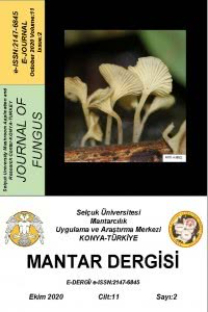Türkiye’de Pleurotus ostreatus Üreticilerinin Karşılaştığı Sorunlar ve Çözüm Önerileri
Kültür mantarı, Pleurotus ostreatus, Üretici sorunları, Çözüm önerisi
Problems and Solution Proposals of Pleurotus ostreatus Producer in Turkey
___
- Aksu, Ş., ve Uygur, A. (2005). Bazı Kayın Mantarı (Pleurotus spp.) türlerinin organik olarak üretimi üzerinde araştırmalar. Anadolu Ege Tarımsal Araştırma Enstitüsü Dergisi, 15 (2), 1-26.
- Ananbeh, K., ve Almomany, A. (2005). Production of oyster mushroom Pleurotus ostreatus on olive cake agro waste. Dirasat Agricultural Sciences, 32, 64-70.Çat, A., Çomak, T., ve Çatal, M. (2018). İstiridye mantarının (Pleurotus ostreatus) tohumluk misel üretimi üzerine bir ön çalışma. Mediterranean Agricultural Sciences, 31 (1), 21–25.
- Demir, H., ve Sönmez, İ. (2011). Antalya’nın Korkuteli ilçesinde kültür mantarı (agaricus bisporus) yetiştiriciliğinin mevcut durumu, sorunları ve bazı çözüm önerileri. Uluslararası Katılımlı I. Ali Numan Kıraç Tarım Kongresi ve Fuarı, (ss. 2431-2439).
- Eira, F. (2003). Cultivo do cogumelo medicinal. Editora Aprenda Fácil, Viçosa, (in Portuguese).
- Erkel, İ. (2004). Kocaeli ve çevresinde mantar üretim potansiyelinin saptanması, Türkiye VII. Yemeklik Mantar Kongresi, (ss. 21-29). Antalya, Türkiye.
- Esen N. C., ve Dernek, Z. (2008). Alternatif besin mantar üretim ve tüketiminde karşılaşılan sorunlar ve çözüm önerileri. VIII. Türkiye Tarım Ekonomisi Kongresi, (ss. 164-175).
- Kibar, B., Akdeniz Duran, H., ve Peker, A. (2016). Pleurotus osteratus yetiştiriciliğinde katkı maddesi olarak mısır silajının kullanımı Uluslararası Tarım Ve Yaban Hayatı Bilimleri Dergisi, 2 (1), 10–17.
- Li, X., Pang, Y., ve Zhang, R. (2001). Compositional changes of cottonseed hull substrate during P. ostreatus growth and the effects on the feeding value of the spent substrate. Bioresource Technology, 80 (2), 157-161.
- Mandeel, Q. A., Al-Laith, A. A., ve Mohamed, S. A. (2005). Cultivation of oyster mushrooms (Pleurotus spp.) on various lignocellulosic wastes, World Journal of Microbiology and Biotechnology, 21 (4), .601-607.
- Moda, E. M., Horii, J., ve Spoto, M. H. F. (2005). Edible mushroom Pleurotus sajor-caju production on washed and supplemented sugarcane bagasse. Scientia Agricola, 62 (2), 127-132.
- Olake, J. K., Adebayo, E. A. (2015). Effectiveness of immunotherapies from oyster mushroom (Pleurotus species) in the management of immunocompromised patients. International Journal of Immunology, 3 (2-1), 8-20.
- Özçatalbaş, O., Eker, N., Özenalp, S. (2004). Korkuteli’nde mantar üretim sektörü, sorunları ve çözüm önerileri. Türkiye VII. Yemeklik Mantar Kongresi (ss. 14-20). Antalya, Türkiye.
- Paksoy, M., ve Aksüt, M. (2012). Mantar tüketimi ve tüketim alışkanlıklarının belirlenmesi: Kahramanmaraş ili örneği. IX. Türkiye Yemeklik Mantar Kongresi. Denizli, Türkiye.
- Pekşen, A. (2014). Türkiye’de kültür mantarı yetiştiriciliği. Yemeklik Kültür Mantarı Çalıştayı (ss. 19-23). Antalya, Türkiye.
- Ragunathan, R., ve Swaminathan, K. (2003). Nutritional status of Pleurotus spp. grown on various agro-wastes. Food Chemistry, 80(3), 371-375.
- Rizki, M., ve Tamai, Y. (2011). Effects of different nitrogen rich substrates and their combination to the yield performance of oyster mushroom (Pleurotus ostreatus). World Journal of Microbiology and Biotechnology, 27(7), 1695-1702.
- Sanchez, C. (2010). Cultivation of Pleurotus ostreatus and other edible mushrooms. Applied Microbiology and Biotechnology, 85:1321–1337.
- Yildiz, S., Yildiz, Ü. C., Gezer, E. D., & Temiz, A. (2002). Some lignocellulosic wastes used as raw material in cultivation of the Pleurotus ostreatus culture mushroom. Process Biochemistry, 38 (3), 301-306.
- ISSN: 2147-6845
- Yayın Aralığı: Yılda 2 Sayı
- Başlangıç: 2010
- Yayıncı: Selçuk Üniversitesi Mantarcılık Uygulama ve Araştırma Merkezi Müdürlüğü
Elif Sena KIRMIZIKAYA, İnci ÇINAR
Tanay UZGAN, Yiğit TERZİ, Füsun Bahriye UÇAR
Fungusların tek isimle isimlendirilmesi ve 2011’den bu yana özellikle Türkiye’deki yansımaları
Ahmet ASAN, Gülay GİRAY, Rasime DEMİREL, Halide AYDOĞDU
Sanem BULAM, Nebahat Şule ÜSTÜN, Aysun PEKŞEN
Fatih BAYDAŞ, Ebubekir ALTUNTAŞ
Butyriboletus fuscoroseus; Türkiye Mikotası için Yeni Bir Boletoid Makrofungus Kaydı
Hakan ALLİ, İsmail ŞEN, Roni Aran ADIBELLİ
Fuat BOZOK, Boris ASSYOV, Hatıra TAŞKIN, Saadet BÜYÜKALACA
Hericium erinaceus (Bull.) Pers. İçin Yüksek Verimli Hibrit Bireylerin Belirlenmesi
Erbil KALMIŞ, Mehmet ATMACA, Fatih KALYONCU
Tricholoma anatolicum ve Tricholoma caligatum’un Morfolojik ve Moleküler Yönden Karşılaştırılması
Meryem BOZKURT, Şenay İLBAN, Sinan AKTAŞ, Tuna UYSAL
Bahar Gülce KORKMAZ, Göksu CEYLAN, İbrahim SARI, Burak Nuri ACAR, Mustafa YAMAÇ
